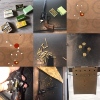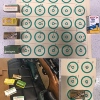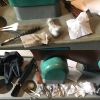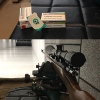Danny Creasy
Member
In my post-apocalyptic series of novels (Slingshot 8, Slingshot 8: The Old World, and the soon to be released, Slingshot 8: Colony) the world as we know it died seven decades earlier. My survivors manufacture some ammunition, but the cost in barter is dear. When scavenged from closets, lockers, and drawers in the Old World, cartridges are a gift. In my series, I never discount the deleterious effects of time, temperature, and moisture on such found ammunition. That said, I recently had the opportunity to purchase a GI ammo can full of firearms related odds and ends. I made an offer, it was accepted, and I took the "treasure" home. About 2000 rounds of .22 long rifle ammunition was accompanied by a couple of hundred rounds of centerfire ammunition and a dozen detachable box magazines. I'll leave the latter for future adventures; the subject of yesterday's shooting and this post is the crusty rimfire ammunition.
I would not foul the barrels of my best rimfires with this stuff, but two old "simple as a brick" firearms would be none the worse for wear if judiciously cleaned following an outing with these scraps. I chose a 60s era three-screw Ruger Single Six revolver and the "bottom of the line" CZ 513 Basic bolt action rifle sporting a Weaver V-16 scope. The test site was a 50 yard lane at the Cypress Creek Indoor Range.
A mysterious, little, unmarked green box contained a loose mix of .22 LR rounds, forty-four to be exact. I chose to hang a target at ten yards, and offhanded, I fired seven cylinder-fulls plus two odd rounds at 3/4-inch dots. The first montage (below) pictures my first cylinder, second, and then the full target. All the cruddy rounds fired with audible and visual full power. A Spared Territory rabbit would probably fill my character's stew pot if engaged with one of these nubbins, as would a headshot assailant fill a grave. I must add that some of these corroded rounds required a little extra effort to seat in the cylinder's chambers, but they all pressed home and went bang.
Now, the rifle deserved a proper benchrest and fifty-yard target. I chose to fire three five-shot groups from each of the four different known-origin ammunitions. I was shooting for groups, so I did not adjust the windage or elevation turrets of the scope. A group's size was what mattered, not its distance from point-of-aim. The rounds from the faded (sometimes tattered and stained) boxes truly impressed me. Heck, the Federal Power-Flite boxes exhibited water damage. As might one of my ST citizens, the occasional, truly frosty-white bulleted cartridges were discarded in what small level of prudence I still possess.
Just as with the handgun, there were no misfires among the seventy old rounds fired through the rifle. These groups were nothing to rave about. However, given that the same rifle, shooter, and windless conditions were used throughout, I think an argument for fair comparison can be made. This was not as much an exercise in accuracy as it was a debunking of the oft heard opinion that aged .22 rimfire ammo will have a high misfire rate (due to dead priming compound) and cause barrel leading (due to deteriorated bullet lube – see third pic and caption below).
The youngest ammo (20 to 30 years old) was probably the Philippine Armscor (first row) and it seemed to group the best. It even bested the touted-in-its-day Western Super Match III (second row). Please note: my research found that the Western cartridges were fifty to sixty years old (senior of the lot). The real surprise was the water-tortured Federal Power-Flite of row three. Back in the early 70s, I remember paying $5.99 for bricks of "Pair-Flite" when they rolled the blue light cart to the sporting goods counter at K-Mart. This Power-Flite was probably the second oldest ammo tested. The late 70s era Remington High Velocity cartridges produced group-killing flyers. After noting the four clustered shots in the third bull of row four, I wondered if the bore had seasoned to the Remmy. Alas, two more bulls showed there was no magic in Big Green then, just as now. As a control, I fired three groups with recently acquired Aguila Standard Velocity (three vertical bulls in the far right column). I wish I had shot the Aguila first as my level of fatigue (the CZ 513's trigger is heavy) and the possible dirtiness of the bore may have expanded this inexpensive go-to ammo's groups. Anyway, the Mexican Aguila's accuracy was much like the test group's.
I have nine boxes of the Power-Flite remaining. Since it is the most damaged of the old cartridges, and thus in greatest need of use, I chose to sight in the 513 Basic with this ammo. The smaller four-bull target displays my four zeroing groups (numbered) with the last one's half-inch bullseye-centered effort bringing warmth to this old shooter's gunpowder-stained heart. I will shoot it away between now and autumn. I'm sure I will wipe a tear as I open the last gold, black, and white box and remember teenage plinking sessions with my high school friends.
Revolver

Rifle

These pics of this morning's cleaning session (revolver on top and rifle on bottom) are evidence that no leading occurred in either firearm during yesterday's test. Both firearms started with clean bores yesterday. None of the patches carried any of the tiny silver shards one finds when cleaning a leaded barrel.

I would not foul the barrels of my best rimfires with this stuff, but two old "simple as a brick" firearms would be none the worse for wear if judiciously cleaned following an outing with these scraps. I chose a 60s era three-screw Ruger Single Six revolver and the "bottom of the line" CZ 513 Basic bolt action rifle sporting a Weaver V-16 scope. The test site was a 50 yard lane at the Cypress Creek Indoor Range.
A mysterious, little, unmarked green box contained a loose mix of .22 LR rounds, forty-four to be exact. I chose to hang a target at ten yards, and offhanded, I fired seven cylinder-fulls plus two odd rounds at 3/4-inch dots. The first montage (below) pictures my first cylinder, second, and then the full target. All the cruddy rounds fired with audible and visual full power. A Spared Territory rabbit would probably fill my character's stew pot if engaged with one of these nubbins, as would a headshot assailant fill a grave. I must add that some of these corroded rounds required a little extra effort to seat in the cylinder's chambers, but they all pressed home and went bang.
Now, the rifle deserved a proper benchrest and fifty-yard target. I chose to fire three five-shot groups from each of the four different known-origin ammunitions. I was shooting for groups, so I did not adjust the windage or elevation turrets of the scope. A group's size was what mattered, not its distance from point-of-aim. The rounds from the faded (sometimes tattered and stained) boxes truly impressed me. Heck, the Federal Power-Flite boxes exhibited water damage. As might one of my ST citizens, the occasional, truly frosty-white bulleted cartridges were discarded in what small level of prudence I still possess.
Just as with the handgun, there were no misfires among the seventy old rounds fired through the rifle. These groups were nothing to rave about. However, given that the same rifle, shooter, and windless conditions were used throughout, I think an argument for fair comparison can be made. This was not as much an exercise in accuracy as it was a debunking of the oft heard opinion that aged .22 rimfire ammo will have a high misfire rate (due to dead priming compound) and cause barrel leading (due to deteriorated bullet lube – see third pic and caption below).
The youngest ammo (20 to 30 years old) was probably the Philippine Armscor (first row) and it seemed to group the best. It even bested the touted-in-its-day Western Super Match III (second row). Please note: my research found that the Western cartridges were fifty to sixty years old (senior of the lot). The real surprise was the water-tortured Federal Power-Flite of row three. Back in the early 70s, I remember paying $5.99 for bricks of "Pair-Flite" when they rolled the blue light cart to the sporting goods counter at K-Mart. This Power-Flite was probably the second oldest ammo tested. The late 70s era Remington High Velocity cartridges produced group-killing flyers. After noting the four clustered shots in the third bull of row four, I wondered if the bore had seasoned to the Remmy. Alas, two more bulls showed there was no magic in Big Green then, just as now. As a control, I fired three groups with recently acquired Aguila Standard Velocity (three vertical bulls in the far right column). I wish I had shot the Aguila first as my level of fatigue (the CZ 513's trigger is heavy) and the possible dirtiness of the bore may have expanded this inexpensive go-to ammo's groups. Anyway, the Mexican Aguila's accuracy was much like the test group's.
I have nine boxes of the Power-Flite remaining. Since it is the most damaged of the old cartridges, and thus in greatest need of use, I chose to sight in the 513 Basic with this ammo. The smaller four-bull target displays my four zeroing groups (numbered) with the last one's half-inch bullseye-centered effort bringing warmth to this old shooter's gunpowder-stained heart. I will shoot it away between now and autumn. I'm sure I will wipe a tear as I open the last gold, black, and white box and remember teenage plinking sessions with my high school friends.
Revolver

Rifle

These pics of this morning's cleaning session (revolver on top and rifle on bottom) are evidence that no leading occurred in either firearm during yesterday's test. Both firearms started with clean bores yesterday. None of the patches carried any of the tiny silver shards one finds when cleaning a leaded barrel.

Last edited:














